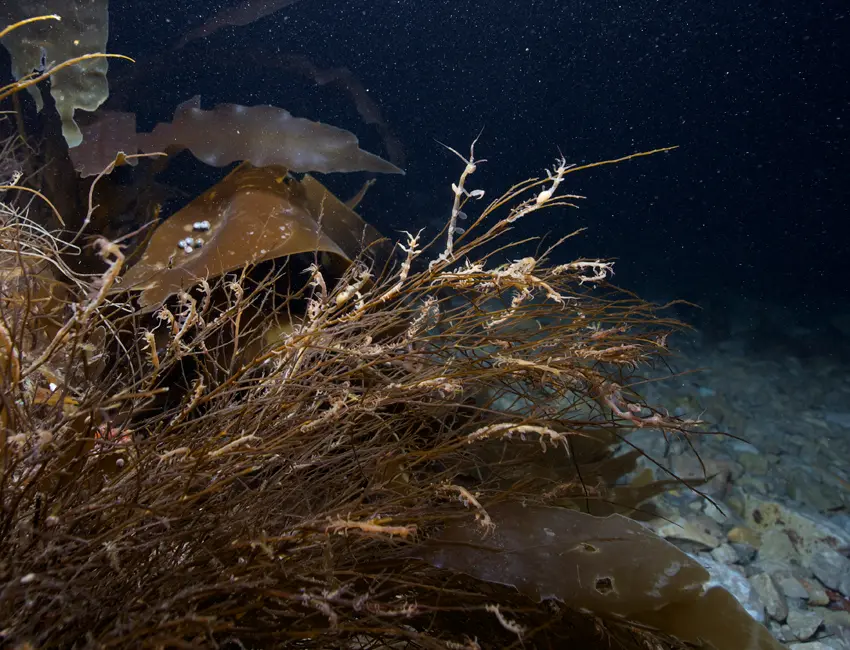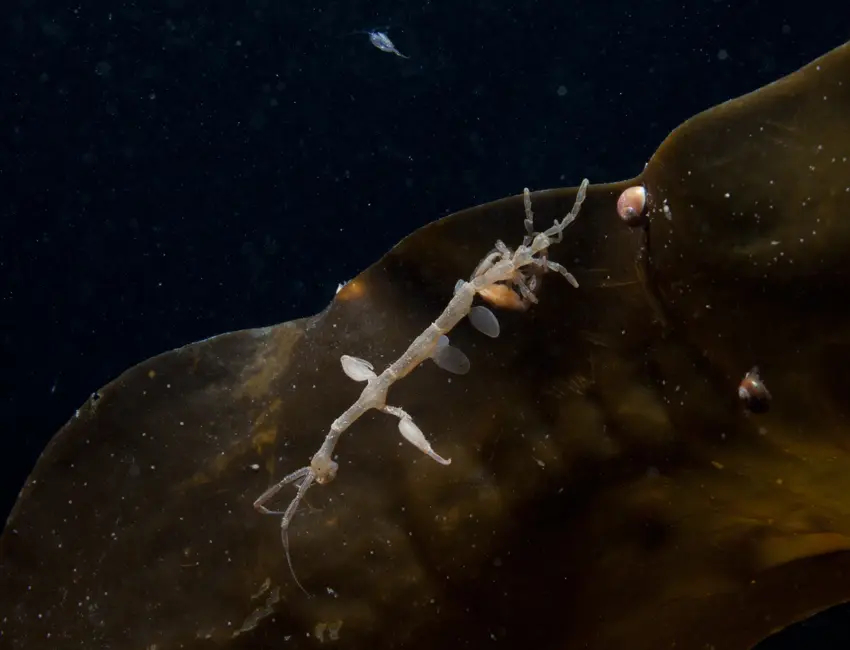About bamboo, ghost shrimps and a changing Arctic

Ghost shrimp (Caprella) on the brown algae Halosiphon tomentosum. Photo: Geir Johnsen, NTNU/UNIS.
Top image: Ghost shrimp (Caprella) on the brown algae Halosiphon tomentosum. Photo: Geir Johnsen, NTNU/UNIS.
Now in the midst of the dark period, it may be appropriate to ask what we really know about life in the north and whether we have enough knowledge to manage resources and waters in a good way. For example, what do we know about bamboo and ghost shrimps on Svalbard?
16 January 2017
Text: Professor Jørgen Berge (The Arctic University of Norway and UNIS) and Professor Geir Johnsen (NTNU and UNIS).
The sea carries many secrets, especially in the north where the dark, the cold and the ice have effectively kept a protective hand over the Arctic Ocean and prevented access for researchers and other investigators.
The year we have just left behind us will go down in history as a record year for little ice cover in the north – previously it has only been once measured less ice than in 2016. Since the start of measuring the extent of Arctic ice by satellite in 1979, the area of permanent ice cover has been reduced by an area equivalent to 60 percent of the EU’s land area. In addition, a recently published study suggests that it will only get worse, and that virtually all perennial ice will disappear from the Arctic over the next 20 years. It is a dramatic change which will have major consequences for the ecosystem and climate.
The problem is that we do not know much about the consequences this has, that we simply have too many knowledge gaps. We need to understand the ecosystem far better and use new methods for identifying, surveying and monitoring our natural resources for a better future management of our oceans. As much as 70 percent of Earth’s surface is covered by ocean water, with an average depth of 3000 meters. In light of this, it will require a great effort to understand our “water planet” and the organisms and species living there.
This concerns especially bamboo and ghost shrimp. But before we take a closer look at them, we must start in another end. Specifically, we must start with the long polar night. Although the sun has now turned and we slowly but surely approach brighter times, it is an indisputable fact that the polar night appears almost like the dark Middle Ages compared with what we know about the Arctic in the summer sun.
Not to sleep
Firstly, it appears that the marine ecosystem in no way lies dormant during the polar night. On the contrary – once you take the trouble to investigate, you find a system that is in full activity. Overwintering birds that hunt food in the dark; shells and zooplankton, which responds to barely visible sunlight and maintains a regular circadian rhythm; and benthic organisms that keep their energy turnover at a high level throughout the winter are just a few, but important examples of activity in the polar night. The message is clear: the system is sleeping. But there are also other processes that turn out to be important, and that puts our current understanding of the system to the test.
In Kongsfjorden on Svalbard, where UiT, NTNU and UNIS has spearheaded a large-scale study of the marine ecosystem in recent years, it has been documented a higher diversity in the kelp forest in winter than at other times of the year. Organisms such as ghost shrimp (Caprellidae), snails and marine worms (Polychaete) can occur in almost unimaginable number among seaweed in the darkest part of the polar night. But not every year. Since we started the studies of the polar night in Ny-Ålesund in 2010, it has only happened twice that we have observed mass occurrence of ghost shrimp. Other years there are other organisms that dominate. So even though biodiversity remains steadily high from winter to winter, no species seem to dominate every year.
Ghost shrimp
Ghost shrimp has, despite its name, little to do with ghosts. On the contrary, they are vibrant and exciting predators who use their huge “crab claws” to catch small prey in the water. One can often see them sitting in hunting position with claws that are ready to capture an unfortunate passing zooplankton. The ghost shrimp belongs to a group of animals called amphipods, although they resemble a praying mantis from the Amazon. We do not know exactly what makes the ghost shrimp occur in such large numbers in some years, but it is natural to assume that it has something to do with reproduction. But why not every year? This is where the bamboo comes into play.

Bamboo
Bamboo belongs to the grass family (hundreds of species and where some may be large as trees) and is known to grow quickly and be important food for animals, including the giant panda. Some species of bamboo are also known not to bloom every year, but rather synchronize its flowering with up to several years. This is generally interpreted as an evolutionary adaptation to reduce the burden of the birds, insects or other animals eating up more or less all the seeds every year. This is sort of nature’s own pest-control and so no species can rely on to regularly feeding on bamboo seeds. Could this be a strategy that can be transferred to the ghost shrimp and other arctic species occurring in large numbers among seaweed each year in the polar night?
Polar night
Something that really characterizes the polar night in Svalbard is the seemingly carefree life of the many overwintering organisms. Potential prey seem to swim carefree in the water or gather in large numbers on kelp. Isolation would constitute a bit of an enigma, but maybe not, if we look at the occurrence of ghost shrimp as a sort of bamboo-adaptation? Could it be that some of the organisms that find their mate or lay their eggs and larvae in shallow waters in the Arctic do this with the same strategy as bamboo? Is ghost shrimp, which is a very slow swimmer and cannot simply escape a predator, an arctic bamboo luring their predators by gathering some years, then be absent in others? It may also be that the ecosystem in the Arctic is so young that not all species have found their niches even with respect to food and shelter? These are just examples of knowledge gaps that we need to identify to get a knowledge management and make wise decisions regarding , for example, man-made changes.
Dramatic change
It is certain that the Arctic is undergoing a dramatic change, and that we within a few years for the first time in modern times possibly will find an ice-free Arctic Ocean part of the year. Such changes require that we know the system, which species live there and not least how they are adapted to life in the north. Then it is rather unsatisfactory to know that our knowledge is largely based on research done in the bright part of the year, while life in the polar night mostly has been wrongly written off as irrelevant and unimportant. Norway as a polar nation has a major responsibility to ensure that we have sufficient knowledge to manage our unique polar areas.
From this perspective it is strange that there is no active surveillance program that includes the marine ecosystem of the polar night. Especially the fact that we in the polar night find mass accumulations of a variety of seaweed species which have great significance, but we do not know why. And this is the core; mass occurrence of such ghost shrimp occur far from each year, but without an active surveillance program that can capture this dynamic, we have no opportunity either to survey or comprehend the ghost shrimp’s (and other species) “bamboo -strategy”. And more importantly; such mass accumulations of organisms that reproduce in shallow waters is not an insignificant factor in the risk evaluations of increased shipping and other activity likely increase with a reduced ice cover.
Any mishap in the polar night can actually have greater repercussions than in other seasons, when eggs and larvae production is at its height. In short, we have a lot of work ahead of us to ensure a knowledge management of an ocean that is about to undergo enormous changes!
This article has previously been published in Aftenposten and Svalbardposten.
